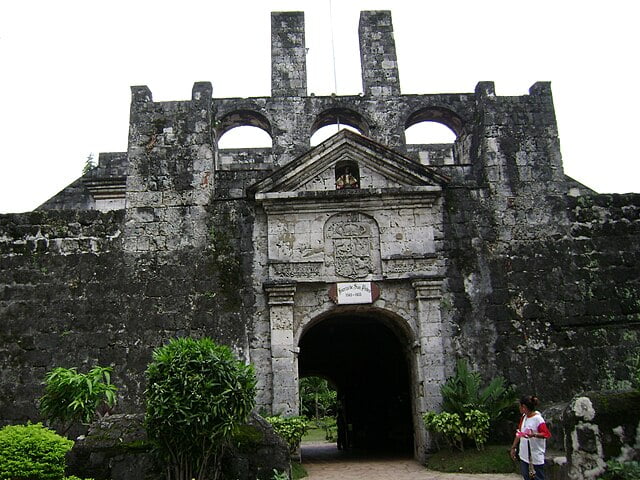In the Central Visayas region, Cebu City is a vibrant metropolis that perfectly blends urban sophistication with rich historical heritage. The city offers an array of Cebu City tourist spots that cater to diverse interests. Here, we delve into some of the most notable attractions within Cebu City. Each offers a unique glimpse into the city’s soul and charm.
Cebu City Tourist Spots: Magellan’s Cross – A Historical Emblem

Magellan’s Cross in Cebu City is a pivotal symbol of the Philippines’ rich history and cultural diversity. Planted by the Philippine discoverer Ferdinand Magellan in 1521, this cross marks the advent of Christianity in the country. Its presence resonates with historical significance and religious reverence. The site, adorned with striking ceiling paintings, narrates the cross’s storied past, attracting history enthusiasts and pilgrims alike.
Magellan’s Cross remains a testament to the enduring legacy of cultural exchange and faith. It plays a crucial role in the historical tapestry of Cebu City.
Tourist Spots in Cebu City: Basilica Minore del Santo Niño – A Symbol of Faith and Resilience
The Basilica Minore del Santo Niño, a revered religious site in Cebu City, Philippines, symbolizes enduring faith and resilience. Constructed in the 16th century, it houses the venerated Santo Niño statue, signifying the introduction of Christianity to the Philippines.
Surviving natural disasters and historical upheavals, the Basilica’s blend of Muslim, Romanesque, and neo-classical architecture reflects Cebu’s rich cultural tapestry. As the epicenter of the annual Sinulog Festival, it draws devotees and tourists alike. It embodies a spiritual heritage that continues to inspire and unite people across generations.
Fort San Pedro: A Historical Gem in Cebu City

Fort San Pedro, a historical fortress in Cebu City, Philippines, is a remarkable example of Spanish colonial architecture and history. Constructed in the 16th century, it served as a military defense structure against invaders.
Today, it has become a cherished museum and park, offering a glimpse into the city’s rich past. Its robust walls and tranquil gardens provide a unique educational and leisure experience. As one of the oldest forts in the Philippines, Fort San Pedro remains a testament to Cebu’s resilience and cultural heritage. It attracts history enthusiasts and tourists alike.
Trip.com Up to 50% off on flights to Asia!(ENG)
Cebu Taoist Temple: A Beacon of Peace and Culture
The Cebu Taoist Temple, perched in the Beverly Hills of Cebu City, is a splendid embodiment of Chinese architectural elegance and spiritual tranquility. This temple is a center for Taoist worship and a cultural landmark. It attracts visitors with its ornate dragons and vibrant pagodas.
The temple’s serene atmosphere and panoramic city views offer a peaceful retreat. It is a testament to Cebu’s cultural diversity and the coexistence of different beliefs. Moreover, the Taoist temple invites all to experience its beauty and tranquility, regardless of religious background.
Cebu Heritage Monument: A Tapestry of History
The Cebu Heritage Monument stands as a grand mosaic of Cebu’s rich history. Crafted by national artist Eduardo Castrillo, this compelling structure in the Parian district is more than a mere sculpture; it’s a narrative in stone and metal. Each figure represents pivotal moments from Cebu’s colorful past, from the era of Rajah Humabon to Spanish colonization and beyond.
This monument honors historical events and educates visitors about Cebu’s significant role in Philippine history. It’s a must-visit for anyone seeking to understand the cultural and historical journey of Cebu and the Philippines.
Museo Sugbo: A Gateway to Cebu’s Rich Heritage
Museo Sugbo, set in the heart of Cebu City, Philippines, is a testament to the region’s vibrant history. Housed in a former provincial jail, this museum uniquely combines its somber past with a rich display of Cebu’s cultural and political history.
Its meticulously curated galleries showcase artifacts from pre-colonial times to contemporary history, offering visitors a comprehensive understanding of the island’s evolution. Museo Sugbo is more than a museum; it’s a cultural beacon, inviting explorers to delve into Cebu’s history and understand the roots that shape its present and future.
Sirao Flower Garden: Cebu’s Colorful Haven
Sirao Flower Garden, often hailed as Cebu’s “Little Amsterdam,” is a vibrant oasis showcasing a stunning array of flowers. This botanical garden, located in the uplands of Cebu City, bursts with the hues of celosias, sunflowers, and other blooms, creating a picturesque landscape.
The garden’s design, featuring windmills and floral arrangements, offers a unique European feel amidst the tropical setting. It’s not just a feast for the eyes; the garden provides a serene escape, inviting visitors to immerse themselves in nature’s beauty and tranquility. Sirao Flower Garden truly encapsulates the blend of natural splendor and artistic creativity.
Tourist Spots in Cebu City: Tops Lookout – A Panoramic Splendor
Tops Lookout is a majestic viewpoint in Cebu City, offering a breathtaking panorama of the metropolis and beyond. This modernist, fortress-like structure captivates visitors with its stunning vistas, especially at sunset.
The vantage point provides a serene escape, enveloping spectators in a tranquil atmosphere away from the city’s hustle. Its circular architecture and the cool mountain breeze add to the allure. Tops Lookout isn’t just a viewing deck; it’s a journey into the heart of Cebu’s natural beauty, presenting an unforgettable experience for locals and tourists alike.
Cebu City Tourist Spots: Casa Gorordo Museum – A Glimpse into the City’s Heritage

The Casa Gorordo Museum in Cebu City is a vivid portal into the Philippine past. This historic house, once the residence of the first Filipino Bishop of Cebu, is a remarkable example of 19th-century architecture. It showcases a blend of Spanish and native Filipino influences, offering visitors an authentic glimpse into the lifestyle of a bygone era.
The museum, with its well-preserved artifacts and period furnishings, not only educates but also mesmerizes, transporting visitors back in time. It embodies the rich cultural heritage of Cebu, making it a must-visit for those seeking to understand the city’s historical tapestry.
Final Thoughts
In conclusion, Cebu City tourist spots offer a diverse and enriching experience, reflecting the city’s rich cultural tapestry and vibrant history. From historical landmarks to natural beauty, each site in Cebu City tells a story of its own, inviting visitors to delve deeper into the heart of this dynamic city. Whether you’re a history enthusiast, nature lover, or cultural explorer, Cebu City holds treasures that promise to make your visit memorable.

Pingback: Cotabato City Tourist Spots: The Epic and Wonderful Trip - Hop 'N Cruise